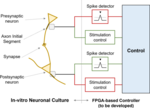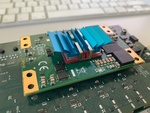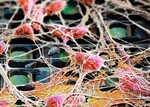Research and Thesis Projects
ETH Zurich uses SiROP to publish and search scientific projects. For more information visit external page sirop.org.
Characterization of Multicellular Interactions in an Immunocompetent Blood-Brain Barrier-on-Chip Platform
 The blood-brain barrier (BBB) is a major obstacle in developing effective therapies for central nervous system (CNS) disorders due to its selective permeability and complex cellular architecture. While organ-on-chip technologies have made significant strides in mimicking basic BBB structure and function, capturing the full scope of multicellular and immune interactions remains a key challenge. This 6-month internship project aims to characterize neurovascular and immune cell crosstalk within an immunocompetent BBB-on-chip model. By utilizing a microfluidic platform that replicates brain microvasculature, the study will assess how these interactions influence barrier integrity under physiological conditions. The results are expected to enhance our understanding of neuroimmune dynamics and support the development of more predictive in vitro models for CNS drug discovery and disease modeling.
Show details
The blood-brain barrier (BBB) is a major obstacle in developing effective therapies for central nervous system (CNS) disorders due to its selective permeability and complex cellular architecture. While organ-on-chip technologies have made significant strides in mimicking basic BBB structure and function, capturing the full scope of multicellular and immune interactions remains a key challenge. This 6-month internship project aims to characterize neurovascular and immune cell crosstalk within an immunocompetent BBB-on-chip model. By utilizing a microfluidic platform that replicates brain microvasculature, the study will assess how these interactions influence barrier integrity under physiological conditions. The results are expected to enhance our understanding of neuroimmune dynamics and support the development of more predictive in vitro models for CNS drug discovery and disease modeling.
Show details
Keywords
Organ-on-chip, Blood-Brain-Barrier, Multicellular Interactions, Neuroimmune Interface.
Labels
Semester Project , Course Project , Internship , Master Thesis
Description
Goal
Contact Details
Published since: 2025-06-17
Earliest start: 2025-07-01
Latest end: 2026-06-30
Organization: Bio Engineering Laboratory
Hosts: M. Gomes Catarina
Topics: Medical and Health Sciences , Engineering and Technology
Monitoring in-vitro neural network dynamics using microelectrode arrays
Join our interdisciplinary research team to explore the fascinating world of neuronal networks in vitro. These master projects focus on culturing neurons on CMOS-based microelectrode arrays (MEAs) to study their electrophysiological properties. The exact project scope will be tailored to your interests and background, offering a unique opportunity to contribute to cutting-edge neuroscience and bioengineering research.
Show details
Keywords
Neuroscience, Cell Culture, CMOS MEA, Electrophysiology, In Vitro Models, Neural Networks, Bioengineering, Neurotechnology
Labels
Semester Project , Internship , Lab Practice , Master Thesis
Description
Contact Details
Published since: 2025-06-08
Earliest start: 2025-06-15
Organization: Bio Engineering Laboratory
Hosts: Cardes Fernando
Topics: Medical and Health Sciences , Engineering and Technology , Biology
FPGA-based platform for in-vitro neural interfaces
 The student will develop an FPGA-based platform for interacting with in-vitro neuronal cultures, including real-time spike detection and neuron stimulation. The project is focused on VHDL programming, although it could include other software development and/or wet-lab tasks with neurons depending on the interests of the student.
Show details
The student will develop an FPGA-based platform for interacting with in-vitro neuronal cultures, including real-time spike detection and neuron stimulation. The project is focused on VHDL programming, although it could include other software development and/or wet-lab tasks with neurons depending on the interests of the student.
Show details
Keywords
VHDL; FPGA; Engineering; Neural interface; In-vitro neuronal culture; CMOS Microelectrode Array; Neuroscience; embedded systems.
Labels
Semester Project , Internship , Bachelor Thesis , Master Thesis
Description
Contact Details
Published since: 2025-06-06
Earliest start: 2022-09-01
Organization: Bio Engineering Laboratory
Hosts: Cardes Fernando
Topics: Medical and Health Sciences , Engineering and Technology
Micropatterned Hydrogel Channels for Proximal Tubule-on-Chip Models
 Microphysiological systems aim to reproduce the complex biological functions and architecture of human organs in vitro. One of the current challenges in the field is to not only replicate physiological flow conditions but also to recreate the key microenvironmental features that govern cellular behavior—such as cell-to-cell interaction, 3D tissue organization and extracellular matrix (ECM) composition.
This 6-month internship project focuses on developing a microfluidic device that integrates a micropatterned hydrogel channel, designed to mimic the architecture and environment of small tubular structures like the proximal tubule of the kidney. The hydrogel will serve both as a biomimetic scaffold and as cellular substrate.
Show details
Microphysiological systems aim to reproduce the complex biological functions and architecture of human organs in vitro. One of the current challenges in the field is to not only replicate physiological flow conditions but also to recreate the key microenvironmental features that govern cellular behavior—such as cell-to-cell interaction, 3D tissue organization and extracellular matrix (ECM) composition.
This 6-month internship project focuses on developing a microfluidic device that integrates a micropatterned hydrogel channel, designed to mimic the architecture and environment of small tubular structures like the proximal tubule of the kidney. The hydrogel will serve both as a biomimetic scaffold and as cellular substrate.
Show details
Keywords
organ-on-chip, ECM, hydrogels, kidney, microfabrication
Labels
Internship , Master Thesis , ETH Zurich (ETHZ)
Description
Contact Details
Published since: 2025-06-06
Earliest start: 2025-07-01
Organization: Bio Engineering Laboratory
Hosts: Garcia Marta
Topics: Engineering and Technology
Software Development: Enabling In Vitro Neuroscience Research
 This 6-month internship focuses on developing software for advanced neural interfaces used in in vitro studies. These interfaces enable precise exploration of neural activity, providing critical insights into neuronal dynamics, drug interactions, and neurological disorders. The project involves creating and optimizing software for data acquisition, analysis, and visualization, which directly enhances the usability and impact of these tools in research and healthcare applications. Ideal candidates will possess strong programming skills in Python, with a preference for knowledge also of C++ and Cython, and excellent documentation practices.
This project is also available as Master thesis or semester project.
Show details
This 6-month internship focuses on developing software for advanced neural interfaces used in in vitro studies. These interfaces enable precise exploration of neural activity, providing critical insights into neuronal dynamics, drug interactions, and neurological disorders. The project involves creating and optimizing software for data acquisition, analysis, and visualization, which directly enhances the usability and impact of these tools in research and healthcare applications. Ideal candidates will possess strong programming skills in Python, with a preference for knowledge also of C++ and Cython, and excellent documentation practices.
This project is also available as Master thesis or semester project.
Show details
Keywords
Internship; Software development; Neural Interfaces; Neuroscience; Python; C++; Cython; Biomedical Research; Neuroengineering; Neurotechnology.
Labels
Semester Project , Internship , Master Thesis
Description
Contact Details
Published since: 2025-05-28
Earliest start: 2025-06-15
Organization: Bio Engineering Laboratory
Hosts: Cardes Fernando
Topics: Information, Computing and Communication Sciences
Microelectronic circuit design for neural interfaces in 0.18um CMOS technology
This project is about the development of integrated circuits to study neurons and neural networks, and may comprise different parts of the design including analog and/or digital microelectronics, PCB design, signal processing and programming.
Show details
Keywords
Microelectronics, CMOS, circuit design, electronics, PCB, signal processing, neural interface.
Labels
Semester Project , Internship , Bachelor Thesis , Master Thesis
Description
Contact Details
Published since: 2025-04-14
Earliest start: 2022-01-03
Organization: Bio Engineering Laboratory
Hosts: Cardes Fernando
Topics: Engineering and Technology
Embedded systems for neural interfaces
 The student will be involved in the development of software applications for in-vitro neural interfaces. The ultimate goal is controlling a complex embedded system, comprising a custom-made CMOS neural interface and two system on a chip.
Show details
The student will be involved in the development of software applications for in-vitro neural interfaces. The ultimate goal is controlling a complex embedded system, comprising a custom-made CMOS neural interface and two system on a chip.
Show details
Keywords
Software development, Python, C++, Linux, Embedded systems, SoC, FPGA, VHDL, Neural interfaces.
Labels
Semester Project , Internship , Bachelor Thesis , Master Thesis
Description
Contact Details
Published since: 2025-04-14
Earliest start: 2024-08-01
Organization: Bio Engineering Laboratory
Hosts: Cardes Fernando
Topics: Information, Computing and Communication Sciences , Engineering and Technology
Microfabrication and characterization of microelectrodes for neural interfaces
 The focus of this project is on the fabrication of microelectrodes for advanced neural interfaces in a cutting-edge cleanroom environment. Our research aims to develop high-resolution neural probes utilizing state-of-the-art microfabrication techniques.
Show details
The focus of this project is on the fabrication of microelectrodes for advanced neural interfaces in a cutting-edge cleanroom environment. Our research aims to develop high-resolution neural probes utilizing state-of-the-art microfabrication techniques.
Show details
Keywords
Microfabrication; Cleanroom; Neural Interfaces; Microelectrode Arrays; Biomedical Devices; Nanotechnology; Electrochemical Deposition; Neurotechnology; Semiconductor Processing; Bioengineering.
Labels
Semester Project , Master Thesis
Description
Contact Details
Published since: 2025-03-12
Earliest start: 2023-12-01
Organization: Bio Engineering Laboratory
Hosts: Cardes Fernando
Topics: Engineering and Technology